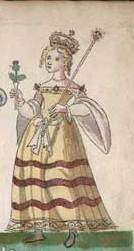Anabella Drummond
| Anabella Drummond | |
|---|---|
 | |
| Queen Consort of Scotland | |
| Tenure | 1390–1401 |
| Coronation | 1390 |
| Born |
ca. 1350 Dunfermline Abbey, Dunfermline, Fife, Scotland |
| Died |
October 1401 (aged 51) Scone Palace, Scone, Perth |
| Burial | Dunfermline Abbey |
| Spouse |
Robert III of Scotland m. 1367; dec. October 1401 |
| Issue |
Elizabeth, Baroness Dalkeith Mary, Countess of Angus Egidia Margaret, Countess of Douglas Robert David Stewart, Duke of Rothesay James I of Scotland |
| House | Clan Drummond |
| Father | Sir John Drummond, 11th Thane of Lennox |
| Mother | Mary Montifex |
| Religion | Roman Catholic |
Anabella Drummond (c. 1350–1401) was the Queen Consort of Scotland by marriage to Robert III of Scotland.
Life
Early life
She was the daughter of Sir John Drummond, of Stobhall, near Perth, 11th Thane of Lennox and Chief of Clan Drummond, and Mary Montifex. It has been erroneous postulated that her father was the same John Drummond that was a brother to Margaret Drummond, Queen of Scotland but as this does not align with any historical dates, the latter John was probably a close ancestor.

.
She married John Stewart (the future Robert III of Scotland) in 1367. Soon, she was enveloped in a power struggle with her husband's brother, Robert. Since Anabella and John did have two daughters, but no sons for several years, he was a supporter of a law that would bar women from inheriting the throne.
Queen
Anabella was crowned with Robert at Scone Palace when he came to the throne in 1390. She continued bearing children until she was past forty and had her last child, the future James I of Scotland, in 1394.[1]
King Robert, an invalid since 1384 due to an accident with a horse, grew increasingly despondent and incompetent throughout his reign and was not capable to govern. During this time he is said to have said to her that he should be buried in a dung heap with the epitaph "Here lies the worst of kings and the most miserable of men".[2]
Because the king was not able to rule, Anabella was prompted to take manage state affairs as de facto ruler. Protecting the interests of her oldest son, David, she arranged a great tournament in 1398 in Edinburgh, where her oldest son was knighted.[3] In April of that year she also called a council where he was created Duke of Rothesay and Lieutenant of the Realm in the same year.[2] Shortly after his mother's death he would be imprisoned by his uncle and died in mysterious circumstances. David was described as debauched, self-indulgent and erratic, and the Duke of Albany did not have to fight hard to control him. The chronicles of Scotland generally praise queen Anabella and her conduct as queen.
The Fife burgh of Inverkeithing was a favorite residence of the queen. Her presence is still recalled in the sandstone font, decorated with angels and heraldry, which she presented to the parish church of the town, one of Scotland's finest surviving pieces of late medieval sculpture.
Anabella died in Scone Palace in October 1401, and was buried at her birthplace of Dunfermline. With the loss of her protection, her eldest son David would become the prey of his uncle, Robert Stewart, Duke of Albany, dying shortly after.[2]
Issue
Anabella had several children with Robert III:
- Elizabeth, married James Douglas, 1st Baron Dalkeith
- Mary, married first to George Douglas, 1st Earl of Angus, second to Sir James Kennedy the Younger (by whom she had Gilbert Kennedy, 1st Lord Kennedy), third to William Graham of Kincardine, and fourth to Sir William Edmonstone of Duntreath.
- Egidia, died young
- Margaret, married Archibald Douglas, 4th Earl of Douglas
- Robert, died young
- David, later Duke of Rothesay
- James, later King of Scots
References
| Wikimedia Commons has media related to Anabella Drummond. |
- Marshall, Rosalind, Scottish Queens, 1034-1714
- Richard Oram: The Kings and Queens of Scotland
- Timothy Venning: The Kings and Queens of Scotland
- Mike Ashley: British Kings and Queens
- Elizabeth Ewan, Sue Innes and Sian Reynolds: The Biographical Dictionary of Scottish Women
External links
| Scottish royalty | ||
|---|---|---|
| Preceded by Euphemia de Ross |
Queen consort of Scotland 1390–1401 |
Succeeded by Joan Beaufort |